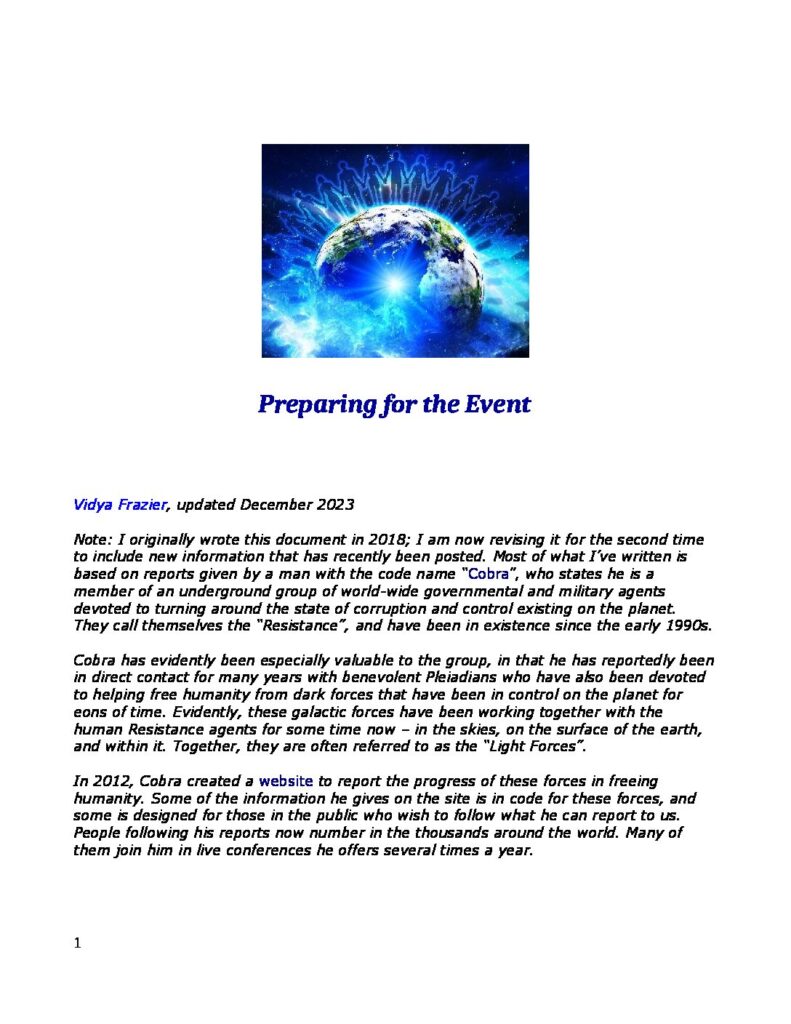 Over and over again on my path of awakening, I seem to have to re-remember the same teaching: that in order to attain on-going inner peace, joy and freedom, I first have to stop resisting what life is giving me—and simply accept what-is.
Over and over again on my path of awakening, I seem to have to re-remember the same teaching: that in order to attain on-going inner peace, joy and freedom, I first have to stop resisting what life is giving me—and simply accept what-is.
I have to remember that if I approach life by resisting what-is and attempt to change things from that position, not only will nothing really change for the better—the inner peace, joy and freedom will continue to elude me.
How often I tend to forget this! And yet there is such relief when I realize that the sense of impatience, irritation or pain I’m experiencing is due to the fact that I’m resisting what-is. Once I become aware of this and move into acceptance, everything in me relaxes. I may still not like what is happening—but I’m experiencing a peace and a sense of freedom with it.
Resistance is Automatic
My resistance can be to anything at all: a situation I find myself in, something someone says to me, a quality in myself I don’t like, the death of a friend. Big or small, if it’s unpleasant or painful to me in any way, my first reaction is to resist it, judge it, try to change it. And, if I check carefully, I find that this reaction generally stems from a sense of fear, anger, judgment or hurt.
And unfailingly, if I try to change something from this position, nothing really changes—or at least for any length of time. My mind simply continues its annoying, resisting chatter, my negative emotions settle in more deeply, and my actions are less than effective. I’m stuck in my resistance.
Whereas, if I’m quick enough to catch my resisting efforts and move into acceptance, the chatter stops, a clarity moves in, and a soft sense of peace and let-go occurs. And I’m able to see what’s really going on inside.
Acceptance vs Passivity
I’ve found that there’s confusion for some about this approach to life: there’s the belief that if you don’t resist things you don’t like and don’t try to change them, you’re going to stay stuck in the same rut you’re in. You’re in a position of passive resignation, of being a victim or doormat. You’re giving up, you’re giving in.
In my experience, this is not at all what the path of acceptance is about. First of all, the practice of accepting what-is is anything but passive. It requires a very active, conscious approach to life, in which you have to continually stay awake and pay close attention to your thoughts, reactions, and actions.
And since, as humans, we seem to be hard-wired to automatically resist anything unpleasant, choosing acceptance in every moment requires constant awareness of our inner processes and a choice that goes counter to this programming.
Courage to Feel Negative Emotions
 Secondly, the path of acceptance is anything but passive, in that it requires a great deal of courage. In order to fully experience acceptance, we need to be open to feeling all the emotions that are present with us regarding whatever it is we’re resisting. And this often isn’t easy.
Secondly, the path of acceptance is anything but passive, in that it requires a great deal of courage. In order to fully experience acceptance, we need to be open to feeling all the emotions that are present with us regarding whatever it is we’re resisting. And this often isn’t easy.
But we must feel these emotions fully—or else we are stuck with them. And they will continue to bring more of the same into our life.
Effective Change
Thirdly, the path of acceptance is not a passive one in which we can’t move to change anything. It simply means that to be effective, our attempts to change must come out of a state of acceptance and understanding of what we want to change—not one of resistance and avoidance.
Effective change derives from an understanding of how something got to be that way to begin with–how we, ourselves, created it to be that way. And until we first accept that something is the way it is, we can’t hope to understand how we created it. Or how to avoid creating it again in the future.
What happens to us in life doesn’t just come out of the blue; in one way or another, we have created it, we have called it into our life. We have brought it in, in order to learn from it. If we immediately resist what comes in, we miss the lesson—and it will either continue to plague us, unresolved—or it will come in again and again, till we get it.
Trusting What Comes into our Life
 So the first step is to simply allow and accept whatever appears in our life, trusting that it’s there for a good reason. We accept that it is reality, for right now. It need not stay here as it is forever; it’s simply here now to help wake us up and move us further along on our path.
So the first step is to simply allow and accept whatever appears in our life, trusting that it’s there for a good reason. We accept that it is reality, for right now. It need not stay here as it is forever; it’s simply here now to help wake us up and move us further along on our path.
As we do this, we can then open ourselves to learn what the lesson is and accept that lesson. We can take responsibility for creating it, which gives us the power to do something about it. And we can then also let go of all negative feelings and judgments we may have toward ourselves or others involved in this situation we wish to change.
With this, we are then ready to move toward change and effectively manifesting what we do want in our lives.
Misconceptions about Manifestation
At first glance, it can look like the teachings about acceptance run counter to the teachings out there about “creating our own reality”—which involve taking control of our life, getting rid of what we don’t want, and manifesting what we do want.
In my experience, these kinds of teachings also hold a lot of truth. Yes, we are powerful beings who can manifest what we want in our lives. We can change ourselves, change our lives, change the world. So how can these two seemingly opposed approaches both be effective?
There is misunderstanding about the teachings of manifestation, just as there is about the teachings of acceptance. It’s often assumed that manifestation arises out of resistance to reality as it is. This is not true. Effective manifestation cannot happen if we’re focusing on the opposite of what we’re attempting to manifest–and this is what we’re doing if we’re resisting the opposite situation. We’re caught in negativity by our resistance.
Effective Manifestation
Clear and effective manifestation happens when we are focused entirely on that which we’re attempting to manifest. And this focus can only happen if we begin with acceptance and understanding of what we’re trying to change. It’s this state of being that brings about the power to change something.
In the end, the change must be an organic kind of shift that emerges—a natural one toward a better, more positive place. There can’t be a pushing. Or anger, hurt or fear motivating us.
The Bonus of Gratitude
 We truly do have the power to create and change whatever we want in life. We simply need to know how to use this power effectively. And this starts with the age-old teachings of accepting whatever appears in our life with open arms—and fully experiencing what-is.
We truly do have the power to create and change whatever we want in life. We simply need to know how to use this power effectively. And this starts with the age-old teachings of accepting whatever appears in our life with open arms—and fully experiencing what-is.
And, if we’re really smart, we bring in gratitude, as well—gratitude for all we’re experiencing. For gratitude not only feels amazingly good; it’s also one of the greatest keys for effective manifestation.










This was an amazingly clear article. Thank you so much for your words